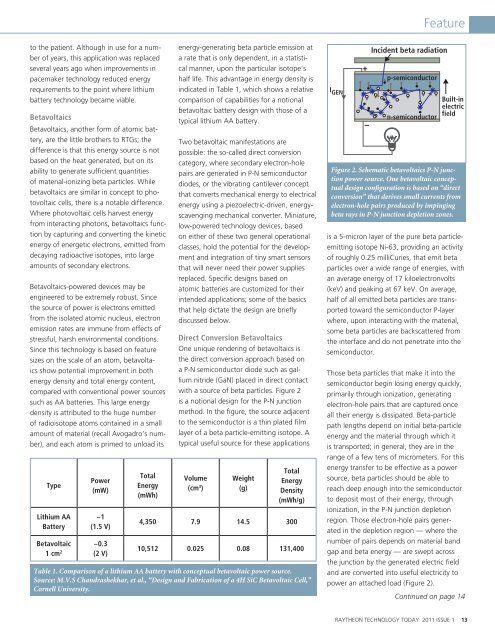Raytheon Technology Today 2011 Issue 1
Raytheon Technology Today 2011 Issue 1
Raytheon Technology Today 2011 Issue 1
You also want an ePaper? Increase the reach of your titles
YUMPU automatically turns print PDFs into web optimized ePapers that Google loves.
to the patient. Although in use for a number<br />
of years, this application was replaced<br />
several years ago when improvements in<br />
pacemaker technology reduced energy<br />
requirements to the point where lithium<br />
battery technology became viable.<br />
Betavoltaics<br />
Betavoltaics, another form of atomic battery,<br />
are the little brothers to RTGs; the<br />
difference is that this energy source is not<br />
based on the heat generated, but on its<br />
ability to generate sufficient quantities<br />
of material-ionizing beta particles. While<br />
betavoltaics are similar in concept to photovoltaic<br />
cells, there is a notable difference.<br />
Where photovoltaic cells harvest energy<br />
from interacting photons, betavoltaics function<br />
by capturing and converting the kinetic<br />
energy of energetic electrons, emitted from<br />
decaying radioactive isotopes, into large<br />
amounts of secondary electrons.<br />
Betavoltaics-powered devices may be<br />
engineered to be extremely robust. Since<br />
the source of power is electrons emitted<br />
from the isolated atomic nucleus, electron<br />
emission rates are immune from effects of<br />
stressful, harsh environmental conditions.<br />
Since this technology is based on feature<br />
sizes on the scale of an atom, betavoltaics<br />
show potential improvement in both<br />
energy density and total energy content,<br />
compared with conventional power sources<br />
such as AA batteries. This large energy<br />
density is attributed to the huge number<br />
of radioisotope atoms contained in a small<br />
amount of material (recall Avogadro’s number),<br />
and each atom is primed to unload its<br />
Type<br />
Lithium AA<br />
Battery<br />
Betavoltaic<br />
1 cm 2<br />
Power<br />
(mW)<br />
~1<br />
(1.5 V)<br />
~0.3<br />
(2 V)<br />
Total<br />
Energy<br />
(mWh)<br />
energy-generating beta particle emission at<br />
a rate that is only dependent, in a statistical<br />
manner, upon the particular isotope’s<br />
half life. This advantage in energy density is<br />
indicated in Table 1, which shows a relative<br />
comparison of capabilities for a notional<br />
betavoltaic battery design with those of a<br />
typical lithium AA battery.<br />
Two betavoltaic manifestations are<br />
possible: the so-called direct conversion<br />
category, where secondary electron-hole<br />
pairs are generated in P-N semiconductor<br />
diodes, or the vibrating cantilever concept<br />
that converts mechanical energy to electrical<br />
energy using a piezoelectric-driven, energyscavenging<br />
mechanical converter. Miniature,<br />
low-powered technology devices, based<br />
on either of these two general operational<br />
classes, hold the potential for the development<br />
and integration of tiny smart sensors<br />
that will never need their power supplies<br />
replaced. Specific designs based on<br />
atomic batteries are customized for their<br />
intended applications; some of the basics<br />
that help dictate the design are briefly<br />
discussed below.<br />
Direct Conversion Betavoltaics<br />
One unique rendering of betavoltaics is<br />
the direct conversion approach based on<br />
a P-N semiconductor diode such as gallium<br />
nitride (GaN) placed in direct contact<br />
with a source of beta particles. Figure 2<br />
is a notional design for the P-N junction<br />
method. In the figure, the source adjacent<br />
to the semiconductor is a thin plated film<br />
layer of a beta particle-emitting isotope. A<br />
typical useful source for these applications<br />
Volume<br />
(cm 3 )<br />
Weight<br />
(g)<br />
Total<br />
Energy<br />
Density<br />
(mWh/g)<br />
4,350 7.9 14.5 300<br />
10,512 0.025 0.08 131,400<br />
Table 1. Comparison of a lithium AA battery with conceptual betavoltaic power source.<br />
Source: M.V.S Chandrashekhar, et al., “Design and Fabrication of a 4H SiC Betavoltaic Cell,”<br />
Cornell University.<br />
I GEN<br />
+<br />
−<br />
Feature<br />
Incident beta radiation<br />
p-semiconductor<br />
n-semiconductor<br />
Built-in<br />
electric<br />
field<br />
Figure 2. Schematic betavoltaics P-N junction<br />
power source. One betavoltaic conceptual<br />
design configuration is based on “direct<br />
conversion” that derives small currents from<br />
electron-hole pairs produced by impinging<br />
beta rays in P-N junction depletion zones.<br />
is a 5-micron layer of the pure beta particleemitting<br />
isotope Ni-63, providing an activity<br />
of roughly 0.25 milliCuries, that emit beta<br />
particles over a wide range of energies, with<br />
an average energy of 17 kiloelectronvolts<br />
(keV) and peaking at 67 keV. On average,<br />
half of all emitted beta particles are transported<br />
toward the semiconductor P-layer<br />
where, upon interacting with the material,<br />
some beta particles are backscattered from<br />
the interface and do not penetrate into the<br />
semiconductor.<br />
Those beta particles that make it into the<br />
semiconductor begin losing energy quickly,<br />
primarily through ionization, generating<br />
electron-hole pairs that are captured once<br />
all their energy is dissipated. Beta-particle<br />
path lengths depend on initial beta-particle<br />
energy and the material through which it<br />
is transported; in general, they are in the<br />
range of a few tens of micrometers. For this<br />
energy transfer to be effective as a power<br />
source, beta particles should be able to<br />
reach deep enough into the semiconductor<br />
to deposit most of their energy, through<br />
ionization, in the P-N junction depletion<br />
region. Those electron-hole pairs generated<br />
in the depletion region — where the<br />
number of pairs depends on material band<br />
gap and beta energy — are swept across<br />
the junction by the generated electric field<br />
and are converted into useful electricity to<br />
power an attached load (Figure 2).<br />
Continued on page 14<br />
RAYTHEON TECHNOLOGY TODAY <strong>2011</strong> ISSUE 1 13

















